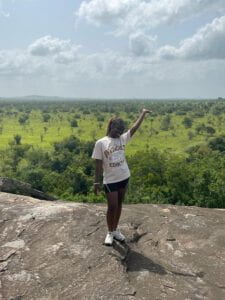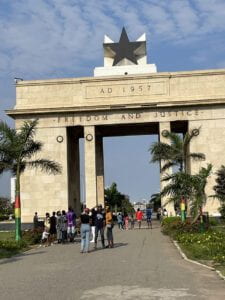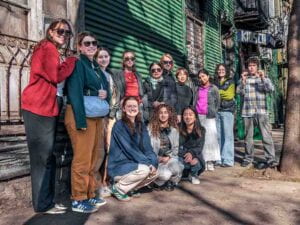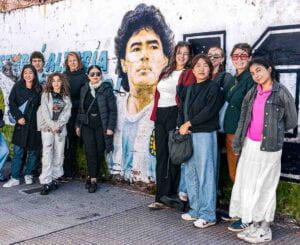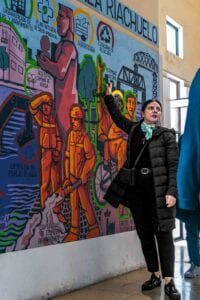Students at NYU Shanghai live and study in one of the most innovative cities in the world. Shanghai, China’s largest city, is a global hub for business, technology, and art. Faculty at the top of their fields teach unique and varied courses across NYU Shanghai’s 19 majors and 23 minors, offering students numerous opportunities to engage with the city as they expand their knowledge and perspective.
The Future of Fashion and Technology
In the innovative NYU Shanghai course Interactive Fashion, Professor Marcela Godoy immerses students in the future of fashion and technology. Specifically, students learn to use computational design, digital fabrication, and soft robotics to create a garment that reflects societal issues. “Historically, what we wear has been used to express our identity and complex issues related to class, race, ethnicity, gender, and sexuality,” says Godoy. “Now, technology allows us to see our clothing as an extension of our bodies.”
Outside the classroom, students engage with the fashion-forward city of Shanghai during trips to unique locations like the 3D Printing Culture Museum of China. At the end of each semester, students showcase their unique creations during a lively runway show.
Service Learning with Impact
Another dynamic course offered at NYU Shanghai is Language and Power with Professor Marcel Daniels. In this course students travel to centers across Shanghai to teach English to migrant communities. Through experiential learning, they explore the social, cultural, and political factors influencing language usage. At the same time, they use their own cultural and linguistic lenses to contextualize their experience. “This course allows students to perform meaningful service to an underserved population while immediately applying insights from the course content,” says Daniels.
Margaret Czarnik, a Social Science major at NYU Shanghai in the Class of 2026, describes Language and Power as her “most extraordinary educational experience.” The course pushed her outside her comfort zone and cultivated a tight-knit community among her classmates. “After a few lessons, I already felt like I was a part of something bigger,” Margaret says. “We were exchanging ideas, sharing experiences, and giving each other advice.” In addition, Margaret uncovered her love of applied linguistics through this experience. “I became so passionate about this field that I presented my final project from the class at the Undergraduate Research Symposium,” she explains.
Movement as a Tool for Exploration, Creativity, and Expression
Students of all experience levels explore the craft of dance creation in Professor Yuting Zhao’s course Choreography and Performance. Throughout the semester, they practice dance combinations and improvisation while creating their own solo and collective works. “Students are invited to think beyond their intellectual world and use their body and movement as a way of understanding and exploring the world,” says Zhao.
For Tate Pan, an NYU Shanghai Class of 2024 graduate who double-majored in Neural Science and Social Science, the Choreography and Performance course was transformative. “Creating art often requires spaces—physical, emotional, and supportive—to move, express vulnerability, and transform it into strength,” says Tate. “This class offers all of that, organically. Despite never considering myself a dancer, this course welcomed me into the world of dance and choreography. It equipped me with tools to express myself creatively through movement.”
Shanghai as the Classroom
In Shanghai Architecture for Chinese Language Learners, Professor Beilei Gu uses Shanghai’s rich architectural heritage as a tool to improve students’ Chinese language skills. Through the class’s innovative integration of language learning and exploration, the vibrant city of Shanghai becomes the classroom. 
“During biweekly city walks, students immerse themselves in the city’s architectural landscape,” Gu says. “Our explorations range from the historic elegance of the international area and the quaint old lanes of Yuyuan Road to the iconic skyscrapers of Qiantan and the architectural marvels of the Bund,” she continues. As a result, these experiences allow students to immerse themselves in the local culture and architecture, fostering a deeper connection with the city.
Look behind the scenes at these and several more innovative courses at NYU Shanghai in the video linked above.
Written by Olivia Richter






